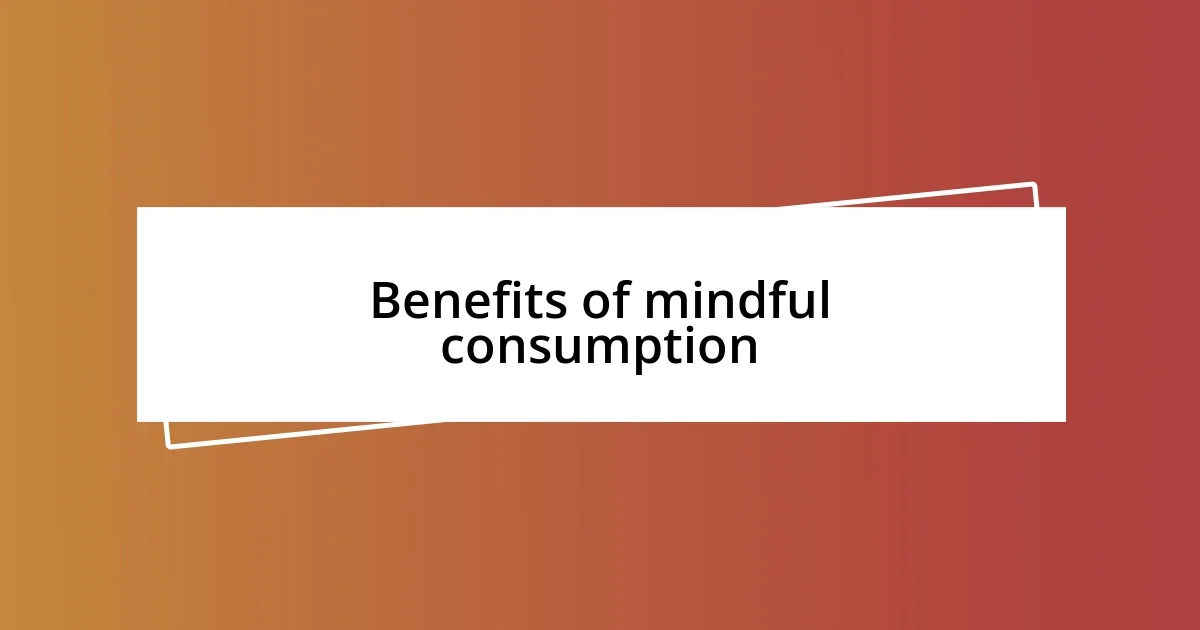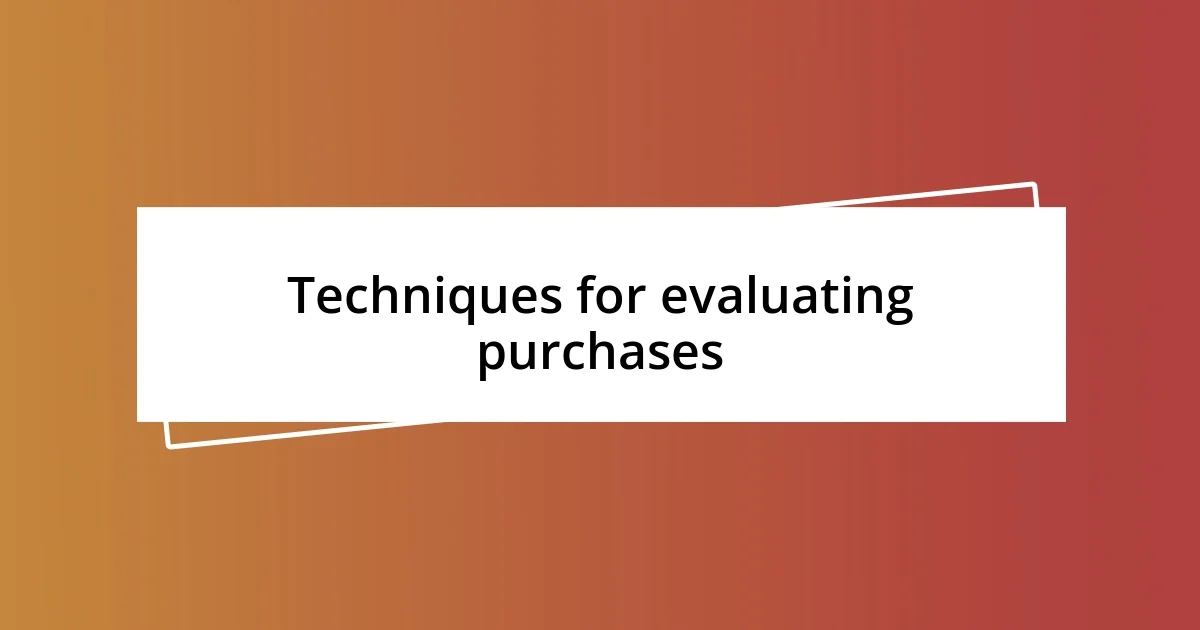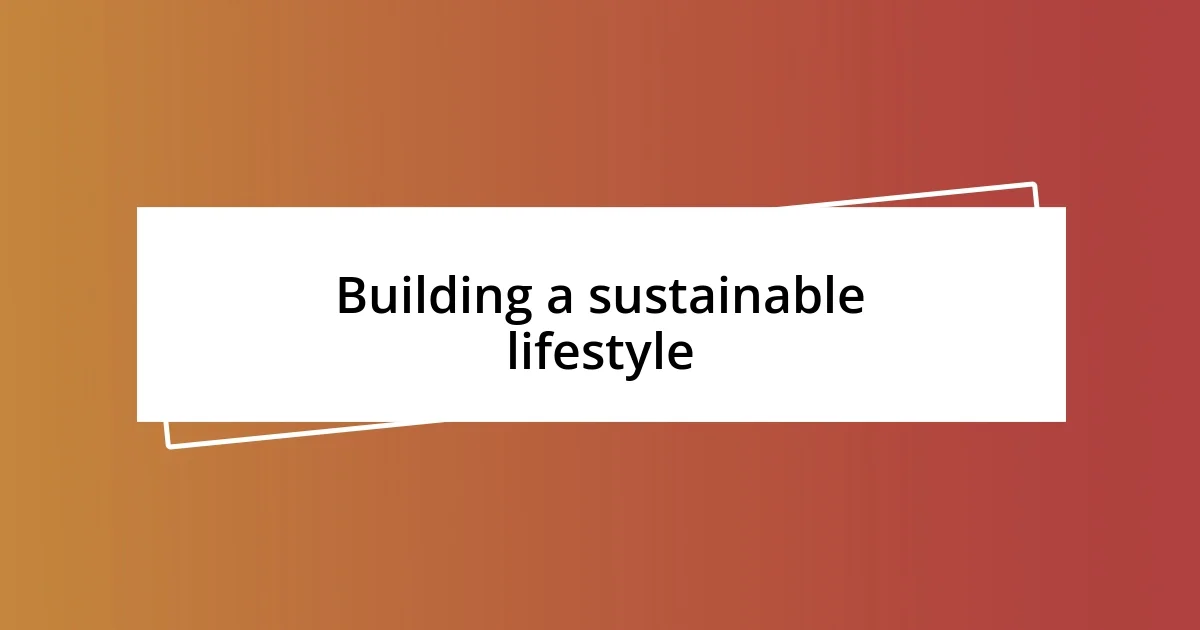Key takeaways:
- Mindful consumption emphasizes making intentional choices based on needs and values, improving relationships with material goods and the environment.
- Practicing reflection, assessing value, and supporting local businesses leads to enhanced well-being, financial savings, and a sense of community.
- Building a sustainable lifestyle involves evaluating food choices, decluttering wardrobes, and prioritizing experiences over material possessions for a more fulfilling life.

Understanding mindful consumption
Mindful consumption is fundamentally about being present in our choices, from the products we buy to the food we eat. I remember walking through a grocery store and finding myself overwhelmed by options, and in that moment, I asked myself: “What do I really need?” This simple question helped me prioritize quality over quantity, allowing me to make decisions that resonate with my values and needs.
When I first began practicing mindful consumption, it was eye-opening to recognize how often I purchased items out of habit rather than genuine necessity. For example, I used to grab snacks without really thinking about their nutritional value. Now, I take a moment to evaluate whether that item will nourish my body or simply fill a craving. This shift in perspective not only improved my health but also made my shopping experience more intentional.
Engaging in mindful consumption has transformed how I view my relationship with material goods. Instead of seeking fulfillment through accumulation, I’ve learned to derive joy from the experience of choosing wisely. Have you ever stopped to consider how your purchases impact both your life and the planet? It’s a profound realization—I feel more connected to the world when I buy with intention, understanding that every choice carries significance.

Benefits of mindful consumption
The benefits of mindful consumption extend beyond personal choices; they ripple into broader societal impacts. I can’t tell you how many times I’ve felt a wave of peace wash over me after choosing to invest in a sustainable product—or even just selecting a local brand. Knowing that my purchasing decision supports ethical practices and reduces environmental harm adds a layer of fulfillment to each transaction I make. It transforms shopping from a mundane task into an opportunity to create positive change.
Here are some notable benefits I’ve experienced with mindful consumption:
- Improved Well-being: Choosing nourishing foods has enhanced my physical health and boosted my energy levels.
- Financial Savings: By prioritizing quality over quantity, I’ve noticed a decrease in impulsive purchases, ultimately saving money.
- Environmental Impact: Mindful consumption contributes to sustainability efforts, reducing waste and supporting eco-friendly brands.
- Emotional Connection: I feel more satisfied when I purchase items that align with my values, leading to a greater sense of purpose in my daily life.

Steps to start mindful shopping
To start practicing mindful shopping, reflection is crucial. Before heading to the store, I often take a moment to write down a list of what I genuinely need. This not only helps me avoid impulsive buys but also reinforces my intention to purchase items that serve a purpose. Have you ever found yourself wandering the aisles and picking up things that ultimately went unused? I certainly have, and it felt wasteful.
Next, assessing the value of what I plan to buy is essential. I ask myself questions like, “Is this item something I’ll truly use?” or “Does it align with my values?” For example, when I decided to invest in a high-quality backpack for hiking, I compared several options, weighing durability against cost. It became clear that spending a bit more on a reliable product would yield more joy and utility in the long run.
Finally, I make a conscious effort to support local businesses and sustainable brands. Each time I choose a product made by a small, ethical company, I feel I’m making a meaningful contribution. This practice has transformed my shopping experiences from transactions to engagements with my community and the planet, enriching my life in ways I hadn’t anticipated.
| Mindful Shopping Steps | Benefits |
|---|---|
| Reflection on needs | Encourages intentional purchases |
| Assessing value | Increases long-term satisfaction |
| Supporting local and sustainable brands | Strengthens community ties |

Techniques for evaluating purchases
When evaluating a purchase, I find it invaluable to create a list of pros and cons. I remember contemplating whether to buy an expensive skincare product. By jotting down its benefits against similar, cheaper options, I realized that the quality and ingredients mattered more to me than the price. This simple exercise helped clarify my decision and made me feel confident about my investment.
Another technique I incorporate is the ‘wait-and-see’ approach. After spotting something I want, I pause for at least a week. This pause often reveals whether the desire was a fleeting impulse or a genuine need. For instance, when I saw a trendy jacket, I walked away and reflected on how it fit into my wardrobe. After five days, I realized I already had similar pieces, and that jacket was no longer alluring. This method saves me money and keeps my closet clutter-free.
Finally, engaging in discussions with friends or family about potential purchases can provide fresh perspectives. I often chat with my friends about the products I’m considering, as their insights challenge my assumptions. Just the other day, I talked to a friend about my plan to buy a new coffee maker. She pointed out an eco-friendly model that I hadn’t considered, which turned my decision into a more thoughtful and informed choice. Involving others not only enriches the decision-making process but also fosters a sense of community. Have you ever found a better option through a simple conversation?

Tips for reducing waste
One of the simplest yet most effective tips for reducing waste is to embrace a “buy nothing” mentality for a week or even a month. I’ve tried this challenge, and it was eye-opening. At first, I found myself craving the instant gratification of shopping but soon realized how much unnecessary clutter I had been accumulating. This pause allowed me to appreciate what I already owned and reconsider my future purchases with a more critical lens. Have you ever found satisfaction in what you already possess rather than what you think you need?
Additionally, opting for reusable items instead of disposable ones significantly cuts down on waste. For instance, I decided to switch to a reusable water bottle and cloth bags for my groceries. At first, I kept forgetting to bring them along, but as these new habits formed, I started feeling a sense of pride in making environmentally conscious choices. When I see others carrying single-use plastics, it reinforces my commitment to going the extra mile for sustainability. Have you ever noticed how easy it is to forget the small changes that make a big impact?
Lastly, don’t underestimate the power of repair and upcycling. I once had a pair of beloved jeans that developed a hole, and instead of tossing them, I added a colorful patch. Not only did this extend the life of the jeans, but it also became a unique fashion statement. This experience taught me that small actions can lead to profound shifts in my perspective on waste. What creative ways have you found to turn potential waste into something valuable?

Building a sustainable lifestyle
Building a sustainable lifestyle often begins with intentional decision-making. For example, I’ve made a conscious effort to evaluate my food choices. When I switched to a local farm box, not only did I embrace seasonal produce, but I also discovered the joy of cooking with fresh, vibrant ingredients. Have you ever felt a deeper connection with your meals when you know where they come from?
Another key aspect is the importance of simplifying my wardrobe. I remember the day I decided to declutter my closet, inspired by the idea of a capsule wardrobe. It was liberating to let go of items that I had kept out of guilt rather than love. Now, each piece I own has a purpose, and it’s easier to mix and match. How would it feel to have a closet that resonates with your style and values?
Lastly, I’ve learned to prioritize experiences over material possessions. I recall a memorable weekend spent hiking with friends instead of shopping. The laughter, the shared stories, and the connection to nature fulfilled me far more than any item could. What experiences can you cherish that don’t come wrapped in packaging? Embracing this mindset has reshaped my values, emphasizing relationships and adventure over consumerism.

Reflecting on your consumption habits
Reflecting on my consumption habits has been a journey of self-discovery. Recently, I took the time to journal about what I buy and why. It was enlightening to see patterns emerge, especially realizing how often I purchased items out of habit rather than genuine need. Have you ever stopped to consider the motivations behind your purchases?
One particular instance stands out to me: I found myself buying books I never got around to reading. Instead of simply adding to my bookshelf, I decided to create a “books-to-read” list and focus only on those that truly piqued my interest. This shift not only reduced unnecessary purchases but also made the reading experience feel more meaningful. How often do we find ourselves accumulating things that don’t serve us?
In reflecting on my consumption habits, I also began to pay attention to the emotional connections tied to my purchases. I realized that sometimes, I shopped to fill a void or escape from stress. This insight prompted me to seek healthier coping mechanisms, like going for a walk or practicing mindfulness, instead of turning to retail therapy. Have you noticed when your shopping is more about emotion than necessity? Recognizing these moments has been freeing, allowing me to foster a more intentional relationship with what I consume.














